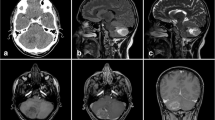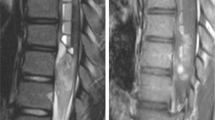Abstract
Cerebellar liponeurocytoma (cLNC), categorized as a World Health Organization grade II tumor, is a rare neoplasm characterized by advanced neuronal/neurocytic differentiation and focal lipid accumulation in neuroepithelial tumor cells. However, the expression and genetic profiling of cLNC have been poorly studied. A 44-year-old woman with a three-year history of cerebellar ataxia and numbness in lower extremities underwent radiological examination revealing multiple contrast-enhancing tumors at the floor of the fourth ventricle and in the lower vermis, and spinal dissemination. The high uptake of 11 C-methionine in positron emission tomography (Met-PET) supported the preoperative cLNC diagnosis. Subtotal removal of the tumor around the obex and inferior vermis was performed. Histologically, the tumor was composed of small, uniform cells with round nuclei in a sheet-like fashion. Tumor cells were diffusely reactive for the neuronal markers synaptophysin and neurofilament. Vacuolate cells with a displacement of nuclei suggested the accumulation of lipid, which was further supported by immunohistochemical staining of S-100. These findings confirmed the diagnosis of cLNC. Next-generation sequencing of tumoral DNA detected a splice site mutation in the ATRX gene. Further reports of cLNC cases with detailed expression and genetic profiles are essential for precise diagnosis and clarifying the oncogenic pathway in cLNC.


Similar content being viewed by others
References
Bechtel JT, Patton JM, Takei Y (1978) Mixed mesenchymal and neuroectodermal tumor of the cerebellum. Acta Neuropathol 41:261–263
Louis DN, Perry A, Reifenberger G et al (2016) The 2016 world health organization classification of tumors of the central nervous system: a summary. Acta Neuropathol 131:803–820
Gembruch O, Junker A, Monninghoff C et al (2018) Liponeurocytoma: systematic review of a rare entity. World Neurosurg 120:214–233
Gembruch O, Junker A, Ahmadipour Y et al (2018) Cerebellar liponeurocytoma - a rare entity: a case report. J Med Case Rep 12:170
Xu N, Cai J, Du J et al (2017) Clinical features and prognosis for intraventricular liponeurocytoma. Oncotarget 8:62641–62647
Borekci A, Kuru Bektasoglu P, Ramazanoglu AF et al (2018) Central liponeurocytoma as a clinical entity. Neurol Neurochir Pol 52:670–676
Hamzaoglu V, Ozalp H, Karatas D et al (2018) Clinical course of the untreated calcified big cerebellar liponeurocytoma. J Surg Case Rep 2018:rjy316
Khatri D, Bhaisora KS, Das KK et al (2018) Cerebellar liponeurocytoma: the dilemma of multifocality. World Neurosurg 120:131–137
Deora H, Prabhuraj AR, Saini J et al (2019) Cerebellar liponeurocytoma: a rare fatty tumor and its literature review. J Neurosci Rural Pract 10:360–363
Guadagno Eulgaovcscm, Pigmatiello S, Elefante A, Maiuri F, Basso De Caro M (2019) Cerebellar liponeurocytoma presenting with fatal tumor hemorrhage. Neurosurg Cases Rev 2
Iwadate Y, Shinozaki N, Matsutani T et al (2016) Molecular imaging of 1p/19q deletion in oligodendroglial tumours with 11C-methionine positron emission tomography. J Neurol Neurosurg Psychiatry 87:1016–1021
Xu L, Du J, Wang J et al (2017) The clinicopathological features of liponeurocytoma. Brain Tumor Pathol 34:28–35
Anghileri E, Eoli M, Paterra R et al (2012) FABP4 is a candidate marker of cerebellar liponeurocytomas. J Neurooncol 108:513–519
Horstmann S, Perry A, Reifenberger G et al (2004) Genetic and expression profiles of cerebellar liponeurocytomas. Brain Pathol 14:281–289
Konovalov AN, Konovalov NA, Pronin IN et al (2015) Multiple primary liponeurocytoma of the central nervous system. Zh Vopr Neirokhir Im N N Burdenko 79:87–96
Takami H, Mukasa A, Ikemura M et al (2015) Findings from positron emission tomography and genetic analyses for cerebellar liponeurocytoma. Brain Tumor Pathol 32:210–215
Takao H, Momose T, Ohtomo K (2004) Methionine and glucose metabolism of central neurocytoma: a PET study. Clin Nucl Med 29:838–839
Soylemezoglu F, Soffer D, Onol B et al (1996) Lipomatous medulloblastoma in adults. A distinct clinicopathological entity. Am J Surg Pathol 20:413–418
Radke J, Gehlhaar C, Lenze D et al (2015) The evolution of the anaplastic cerebellar liponeurocytoma: case report and review of the literature. Clin Neuropathol 34:19–25
Heaphy CM, de Wilde RF, Jiao Y et al (2011) Altered telomeres in tumors with ATRX and DAXX mutations. Science 333:425
Jayasinghe RG, Cao S, Gao Q et al (2018) Systematic analysis of splice-site-creating mutations in cancer. Cell Rep 23:270-281.e273
Koschmann C, Calinescu AA, Nunez FJ et al (2016) ATRX loss promotes tumor growth and impairs nonhomologous end joining DNA repair in glioma. Sci Transl Med 8:328ra328
Acknowledgements
None.
Funding
This work was supported by JSPS KAKENHI Grant Number 20K17952.
Author information
Authors and Affiliations
Corresponding author
Ethics declarations
Conflict of interest
The authors report no conflict of interest concerning the materials or methods used in this study or the findings specified in this paper.
Ethics approval
Ethical approval was not applicable for the case report. Written consent was obtained from the patient to participate in this case report.
Informed consent
Written informed consent was obtained from the patient for publication of this case report and any accompanying images. A copy of the written consent is available for review by the Editor-in-Chief of this journal.
Additional information
Publisher's Note
Springer Nature remains neutral with regard to jurisdictional claims in published maps and institutional affiliations.
Rights and permissions
About this article
Cite this article
Hirono, S., Gao, Y., Matsutani, T. et al. Metabolic, immunohistochemical, and genetic profiling of a cerebellar liponeurocytoma with spinal dissemination: a case report and review of the literature. Brain Tumor Pathol 38, 257–262 (2021). https://doi.org/10.1007/s10014-021-00405-2
Received:
Accepted:
Published:
Issue Date:
DOI: https://doi.org/10.1007/s10014-021-00405-2




